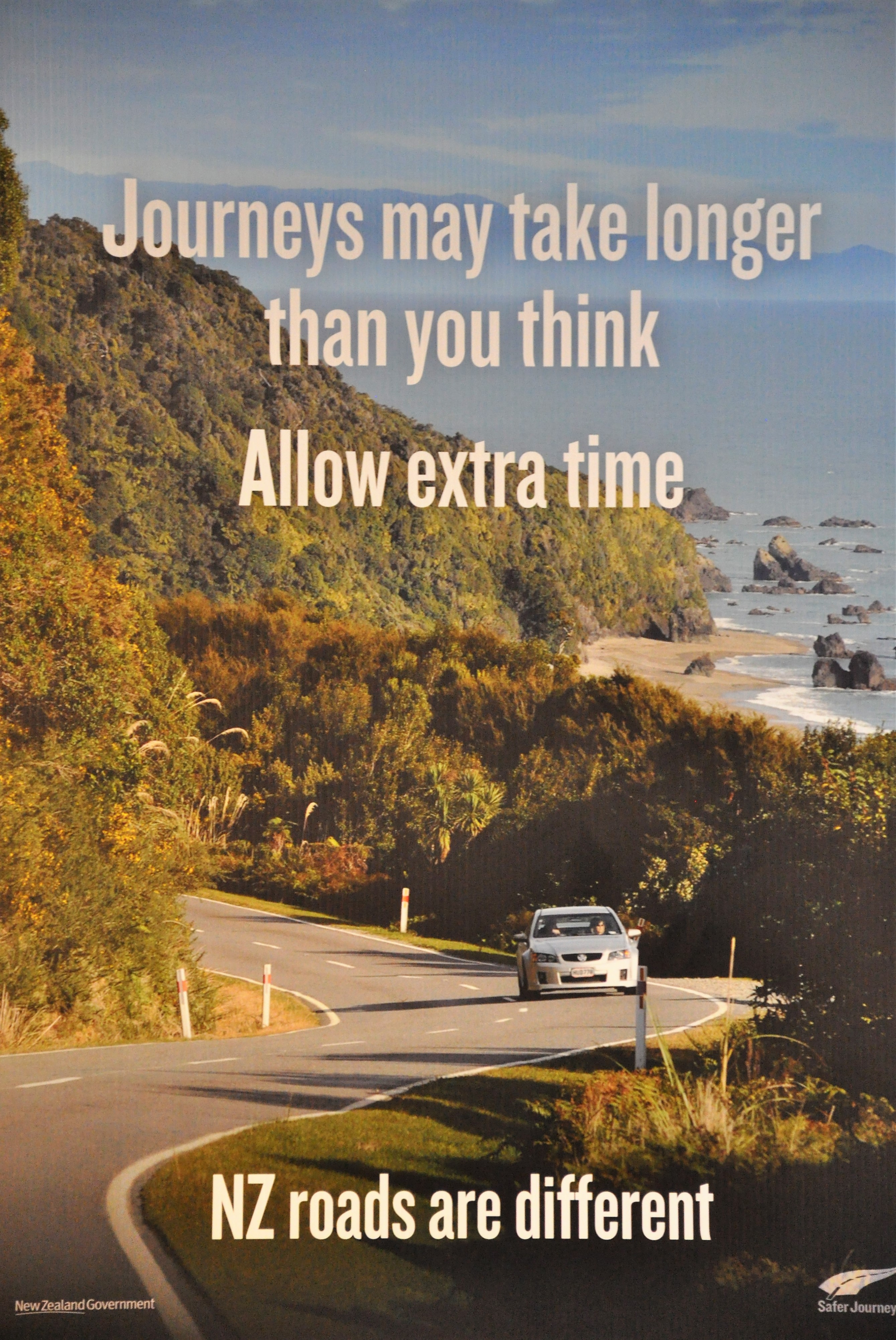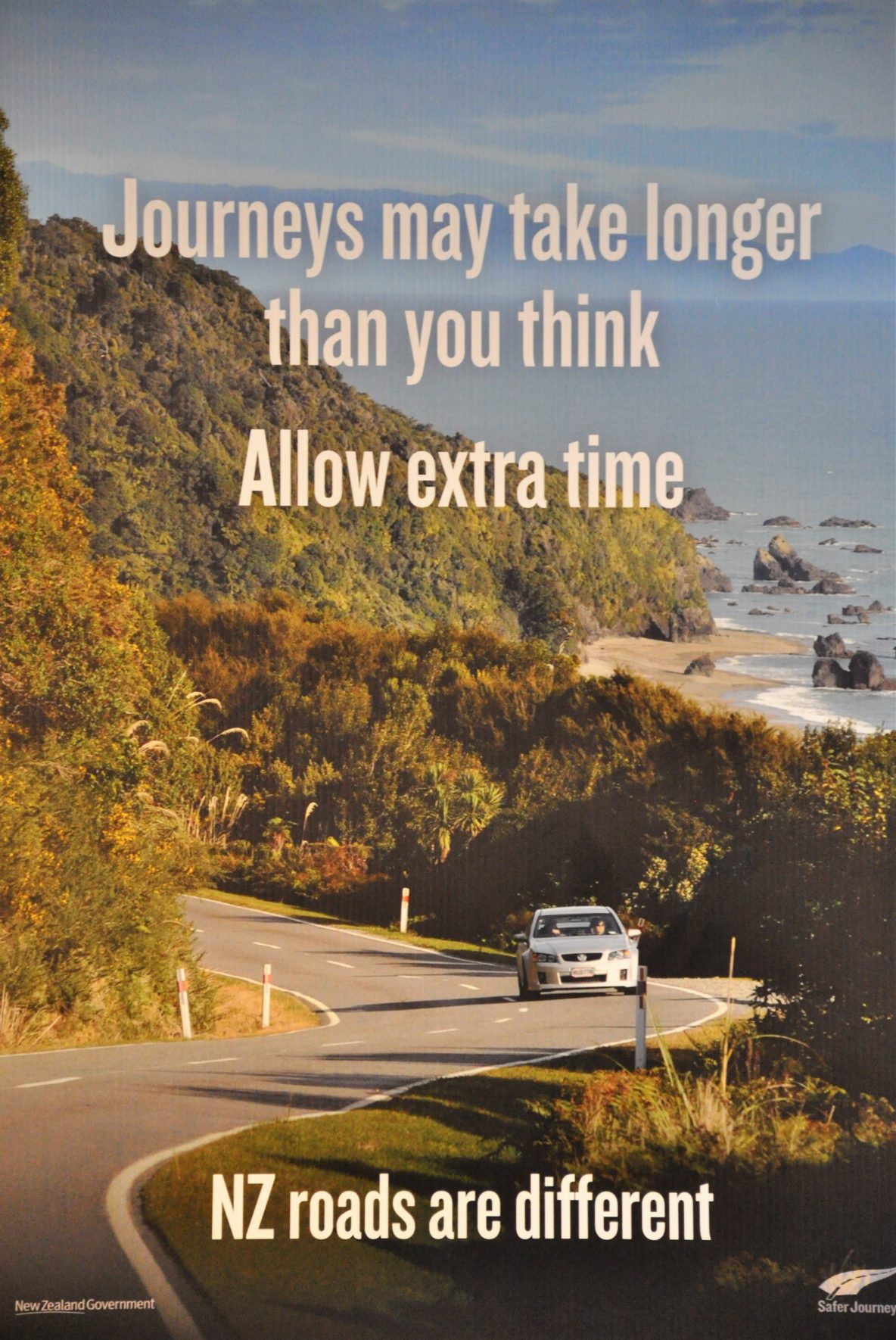The Plan
As you can see from the map of our travels we were in every region of the country except for the far east (Gisborne) and far west (Taranaki) of the North Island. We stayed at least one full day and night in every region as well except for Manawatu-Wanganui, the region immediately north of Wellington.
The plan was really great. There were no places that we went where we felt we could have skipped. A few museums and walks were underwhelming, but were generally a small part of an otherwise amazing day. In hindsight we should have made Golden Bay a locale where we would have stayed and biked rather than going for just a day trip, and maybe we should have done something in Auckland.
Weather only defeated us twice – on the West Coast (although when we have mentioned this to New Zealanders they say “Of course it rained on the west coast” and they’re amazed that we had good weather on the cruise on Doubtful Sound) and for the whale watch in Kaikoura.
Biking in New Zealand
We love traveling and biking, so most of our travel plans are either centered around or include some biking. About five years ago we bought a tandem bicycle (Co-Motion Equator) which can be uncoupled and packed into two airline-regulation suitcases. We have taken it on a number of overseas and cross-country flights and that was the initial thought when we started planning the trip to New Zealand. Then we discovered the Great Rides of New Zealand, the wonderful off road trails that have been built to showcase the best of NZ scenery from a bicycle. We also learned that many of the roads in NZ are not really safe for cycling and that has certainly been confirmed by our experience driving here and the small number of cyclists that we’ve seen on the roads, both touring and recreational.
The challenge with the Great Rides is that they are generally unpaved and lean far more to the mountain bike track than the rail trail type of off road. That took the tandem out of the picture both for handling and lack of capacity for bigger tread tires.
The solution was to purchase bicycles here from a company that has a buyback program. We used Natural High in Auckland and were very happy with the Avanti Discover bikes. We also stuck to the grade 1 and 2 cycling trails.This is a serious mountain biking country, intermediate means you need to be comfortable being air borne I believe! We did about 520 kms mostly on the Great Rides. As always, biking opens up different opportunities to connect with locals and other travelers and gives you a much deeper view of the landscape. I believe that my new found deep appreciation for sheep was built primarily on the bike as we slowly rode by them and often stopped just to watch the little lambs running around and trying to cajole the ewes into feeding them.
Food
NZ eggs are wonderful with big rich yolks. Look for them on the shelf or at local farms. They are never refrigerated. We made some great dinners with eggs, veg and local cheese. Lemons are also excellent in NZ, especially squeezed onto local fish. Spring is not the best time for vegetables so we mostly stuck to capsicums (peppers), kumara (winter squash), and cucumbers. The cafes all have meat pies and sausage rolls. There’s a lot of meat in both and one sample was enough for me. Fish and chips are usually good but they did not adopt the British vinegar tradition! Blue cod and gurnard are generally the fish in fish and chips and are often available grilled as well. Beetroot is all over the place; in salads, as a relish on hamburgers, etc.
Green mussels are often available, particularly in the north of the South Island, either as an entree (which translates to “starter” in the UK and “appetizer” in the US) or in a combo seafood plate as a main. Havelock is the green mussel capital of the world. They are farmed, and the process is quite interesting – starting with scooping up baby mussels on Ninety Mile Beach on the North Island – and completely “natural”, no added nutrients or hormones, just getting them to attach to long ropes and leaving them in the water for a few years.
Real Fruit ice cream is fantastic and I am amazed that we do not have this treat in the US. They have a special machine that mixes softserve ice cream or frozen yogurt with actual real fresh fruit order by order and it is delicious!
Coffee
I’ve never seen so many big professional espresso machines. They are in gas stations, pubs and the smallest of cafes. Brewed coffee is rare. They drink it strong but will either add extra hot water or give you a pitcher with hot water if you ask for an Americano.
Restaurants
Every town has several cafes and often a hotel with a pub. Cafes also pop up seemingly in the middle of nowhere and at many tourist attractions. The protocol varies but the most common is that you find a menu up by the cash register, peruse the self service case with the meat pies and then grab yourself a table. When you know what you want, you order up at the register and get a number that you put on your table. Your meal and drinks will be served but you then need to go up to the register to pay. Occasionally you get full table service but that’s generally in fancier restaurants in larger cities. Look around for water and glasses to serve yourself – often in a refrigerated case. Silverware and napkins are in a container on each table so set your own place. Sounds very simple but was completely baffling us for a while.
Hotels, bachs and holiday parks
You can travel for reasonable cost in NZ if you are willing to do some homework and have a reasonable level of tolerance and flexibility. Many of the lower cost motels have big rooms with kitchenettes and laundry facilities. Bachs (pronounced “batch”) can be great value if you are willing to stay a bit outside of the tourist centers. We enjoyed meeting many of the owners and always appreciated the small welcome food gifts they would leave. We always got fresh milk even at the motels. We had bachs that left us wine, eggs, cookies, crisps, and even a frozen chicken! Central heating is not a thing in NZ! Look for the space heaters and sometimes a heat exchange system. We were cold until we figured this out! Holiday parks are very basic but the shared facilities were always clean and plentiful.
Two months is long enough to get a pretty good impression of a country. Hardly an expert opinion, but enough to have watched (and enjoyed some) junky TV. We had never heard of “Gogglebox” or “Married at First Sight” which have both been around in other countries for a while, but the NZ versions of them are junk TV at its best.
Biking:
520 K.
Driving:

The roads here are definitely different. There are motorways near Auckland, Wellington and Christchurch and that’s about it. There is some expansion of the motorways in progress – particularly north of Auckland. However, most of the road works that we encountere, other than general repaving which usually includes a LOT of gravel on the roadway, is to repair extensive damages from earthquakes (particularly around Kaikoura) and cyclones (on Tekaka Hill and Golden Bay). So, no demerits for dealing with natural disasters. However, they build roads to a different standard here. Mountainous roads (and there are a lot) have inclines and curves that we would never consider reasonable even on a back road. These sections of roadway are found on the main roads connecting large towns. It is not uncommon to see signs indicating that the upcoming curves should be taken at 25 (that’s Km! which is roughly 15 mph). I think that I can safely say that there is no public road in America where the recommended speed limit is 15 mph.
Another different feature of New Zealand roads is one-lane bridges. They are everywhere! They are working to remove them on major roads, but on State Highway 1 – the major connecting road on the east coast of both the North and South islands – there are several one-lane bridges. When coming up on a one-lane bridge there will be a sign indicating which direction has the right of way. You then pull forward until you get a sight-line to see if it’s OK for you to cross. On smaller roads in less well-traveled areas you can encounter dozens of these bridges on a short drive. My favorite was one which was so long that you couldn’t see the other side to know if someone had started across in your direction. On that bridge they built two pull-outs so that if two cars were crossing in opposite directions one could pull off to let the other pass. If more than one car was coming in both directions I’m not sure how that would work. Fortunately, we got all the way across without encountering another car. That seems to be the major premise behind their road design: “Hey, there isn’t much traffic here, so no worries!”
This also applies to safety features, particularly guard rails. They are not commonly found on New Zealand roads. There was a sheer dropoff of many hundreds of meters on a long stretch of Tekaka Hill with no guard rail. It was seriously frightening. But, “No worries!”
The New Zealand Transport Agency is great, however, with putting up billboards suggesting ways to drive safer, letting you know when you are entering a “Frequent Crash Zone”, or asking you to call 0800-44-44-49 to find out about road conditions or to report any hazards. One day we counted ten different hazards that they asked us to report: “Stock on the highway – call 0800-44-44-49”, “
